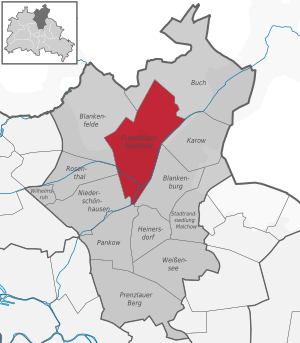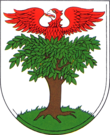Berlin-French Buchholz
|
French Buchholz district of Berlin |
|
|---|---|
| Coordinates | 52 ° 36 ′ 0 ″ N , 13 ° 26 ′ 0 ″ E |
| surface | 12.03 km² |
| Residents | 21,281 (Dec. 31, 2019) |
| Population density | 1769 inhabitants / km² |
| Post Code | 13127 |
| District number | 0310 |
| Administrative district | Pankow |
French Buchholz (short: Buchholz called) is a Berlin district in the Pankow district , which developed from an earlier settlement area in the 13th century. The place got its name because at the end of the 17th century numerous Huguenot families settled here, religious refugees from France .
history
From the foundation to the end of the 19th century
The Angerdorf Buchholz was probably founded around 1230, like most of the villages on the southern Barnim . The village of Buckholtz is mentioned for the first time in a document from 1242 as a border town of Schönerlinde . The land book of Charles IV from 1375 shows 52 hooves for Buchholz , four of which are parish hooves and one church hoof. Eight free hooves belong to Bredow's . The village has a pitcher . The village church made of stone blocks was built at the beginning of the second half of the 13th century.
After numerous changes of lordship ( von Schlieben , von Thümen and von Röbel ), Buchholz came into the possession of Elector Friedrich Wilhelm in 1670 , who had owned shares since 1641. Since many farms and farms in Buchholz were devastated or abandoned after the Thirty Years' War , as a result of the Edict of Potsdam in 1685, Minister of State Joachim Ernst von Grumbkow formed a "French colony" by settling Huguenots . In 1687, the first ten farming and six gardening families from France settled here. In 1688 there are already 87 settlers. They grew previously unknown plants such as green beans , cauliflower , asparagus , artichokes and various culinary herbs and planted fruit trees . From around 1750 the name French Buchholz became common . The village became a popular destination for Berliners. An etching Pilgrimage to Frantzösch Buchholz by Daniel Chodowiecki also dates from this year . Jean-Pierre Blanchard performed his first manned free balloon flight in Berlin in 1788 and, coming from the Tiergarten , landed in Buchholz with his “Luftball”. From 1817 to 1913 the district was officially known as French-Buchholz .
In the 20th century
From 1913 onwards, due to anti-French resentment and in the run-up to the First World War, the community was renamed Berlin-Buchholz . The incorporation into the area of Greater Berlin took place in 1920.
After the end of World War II , Buchholz became part of the Soviet Sector of Berlin . Around the former center of the Lehnschulzendorf, a mixed development of one to four-story residential buildings had gradually developed. In addition, horticultural companies, small industries, allotment gardens and workshops of craftsmen shaped the district.
Worth mentioning 1965-1967 on behalf of is GPG trefoil according to the design of the Architektenkolletivs G. Hänelt built greenhouse Kombinat on Berliner Strasse 45. The building included a multipurpose greenhouse in steel and glass combination (approximately 2.5 hectares of land) for industrial production of Early vegetables and ornamental plants, a powerful heating plant (four boilers with a total of 7.2 million kilocalories) and a social building that the architect H. Reichard had planned.
After the fall of the Berlin Wall , at the suggestion of several regional associations, the district was renamed Pankow on May 30, 1999 by the district council assembly and received its previous name again after 86 years. The memorial plaque for the re-naming reads:
"In the awareness of our Franco-German tradition of fruitful cooperation in tolerance and mutual respect, this name stands for the unifying, the historical and the new."
In the late 1990s, the district had designated extensive new development areas. Mainly medium-high apartment buildings were built along Rosenthaler Weg and Triftstraße, supplemented by school and sports buildings as well as retail and green spaces.
The Karower ponds in the north of the district were declared a nature reserve in 1994 .
In the 21st century
An urban development plan published by the Berlin Senate in 2018 stipulates that a previously fallow area of around seven hectares around the town center will be restructured for mixed use. In addition, according to this project, an area of around 23 hectares on the east side of Berliner Straße will be used for residential development; Around 550 new apartments are planned by 2025.
Infrastructure and economy
traffic
In 1860, the Berlin suburb received a horse-drawn bus service that ran to Berlin's Alexanderplatz from 1866 . From 1877 there was another connection to the Blankenburg station , which from 1895 was led to the Pankow-Heinersdorf station. In 1904, the community's own horse tram replaced the Berlin horse tram.
With the electrification of tram traffic, the former horse tram was transformed into a tram line in 1907 that ran between the church in Buchholz and downtown Berlin . Lines 24 and 49 operated until 1953, when line 24 was discontinued.
As a result of the fall of the Berlin Wall , the previously separate Berlin transport companies grew together, the routing including the numbering was compared. Since 1993 the tram line 50 with a change at the S-Bahn station Pankow-Heinersdorf has ensured the connection to Berlin city center.
Until 1990, a Buchholz S-Bahn station was planned on today's S-Bahn line S 8.
The 154 bus connects Buchholz to the north-east of Berlin via the neighboring Blankenburg S-Bahn station. Line 124 runs from French Buchholz via the Wittenau S-Bahn and U-Bahn station to Heiligensee .
The federal highway 109 between downtown Berlin and the federal highway 114 runs through the district. The interchanges Pasewalker Straße , Bucher Straße and Schönerlinder Straße of the A 114 are on the territory of the district.
Companies
The fireworks company Pyrofa (Silberhütte Pyrotechnische Fabrik Buchholz) had its headquarters here until 2015. The manufacture of fireworks began at the beginning of the 20th century, and a kind of factory sale was also possible in the 1980s. When the state-owned companies were dissolved or sold after the political change , the Diehl Group acquired the entire facility from the Treuhandanstalt for a symbolic German mark . Production continued for a few years, then management sold the fireworks division to a Chinese manufacturer. In the early 2010s, the factory halls in French Buchholz were demolished and the site cleared. Presumably it now serves as reserve space for future investors.
Pilgrimage to Frantzösch Buchholz , etching by Daniel Chodowiecki
Kossatenhof in French Buchholz
Personalities
- Franz Carl Achard (1753–1821), developer of the process of extracting sugar from beets, landowner in French Buchholz
- Willy Werner (1868–1931), painter, lived in French Buchholz
- King Repp (1898–1968), juggler, lived in Buchholz, France
- Helmut Faeder (1935–2014), soccer player, born in Buchholz, France
See also
- List of streets and squares in Berlin-French Buchholz
- List of cultural monuments in Berlin-French Buchholz
literature
- Reinhard Demps et al. : Tram story (s). Trams to Buchholz . Ed .: Buchholzer Bürgererverein e. V. Verlag GVE, Berlin 1999, ISBN 3-89218-064-4 .
Web links
- History of French Buchholz
- Ortschronik von Französisch Buchholz ( Memento from August 11, 2006 in the Internet Archive )
- The Evangelical Church Community in French Buchholz
Individual evidence
- ↑ Roland Bauer et al. : Berlin - Illustrated Chronicle until 1870 . Berlin 1987, ISBN 3-320-00831-5 , p. 126, 198 .
- ^ Joachim Schulz, Werner Graebner: Berlin. Capital of the DDR. Architecture guide GDR. VEB Verlag für Bauwesen, Berlin 1974; P. 118.
- ↑ Werner Gahrig: Huguenots in Berlin and Brandenburg. Verlag Das Neue Berlin, Berlin 2005, p. 221.
- ↑ Ulrich Paul: On field and corridor. Where Berlin is growing: The Senate is planning eleven new residential areas. The Berliners should have a say. In: Berliner Zeitung (print edition), May 29, 2018, p. 14.
- ↑ Pyrofa products on www.feuerwerksvitrine.de , accessed on June 20, 2018.
- ↑ Demolition of the Pyrofa building at www.feuerwerkforum.de, accessed on June 20, 2018.










